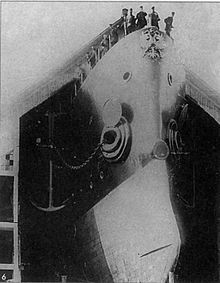Aurora (ship, 1900)
|
||||||||||||||||
|
||||||||||||||||
|
||||||||||||||||
|
||||||||||||||||
The Aurora ( Russian Аврора Awrora ) is a warship of the former Imperial Russian Navy and has been a museum ship in Saint Petersburg since 1956 . The ship is known as the armored cruiser Aurora as a symbol of the October Revolution and is one of the few preserved protected cruisers .
Ship type
The Aurora was the third Pallada- class ship designed and built in Russia to reinforce the Baltic fleet . The cruisers should both perform tasks in the Baltic Sea and operate worldwide, especially in the Far East. The ships of this class are known as armored cruisers or armored deck cruisers . They were smaller and less armored than the armored cruisers . The lead ship Pallada was laid down in 1895 and completed in 1901. During this time, the Russian Navy had placed construction contracts abroad for more powerful cruisers of similar size ( Varyag , Askold , Bogatyr ), which were delivered between January 1901 and August 1902.
history
construction
The ship was built on May 23rd . / June 4, 1897 greg. started at the New Admiralty Shipyard in Saint Petersburg. The on May 11th jul. / May 24th 1900 greg. the stack overflowed Aurora was on July 16 jul. / July 29, 1903 greg. put into service.
commitment
The Aurora was assigned to the Pacific squadron in Port Arthur , in which its sister ships Pallada and Diana had been stationed since April 1903.
Transfer to the Pacific Fleet
The Aurora set off for the Far East with the next transfer formation under Rear Admiral Andrei Wirenius , together with the old armored cruiser Dmitri Donskoy and seven Buiny- class torpedo boats . In December 1903 the ship of the line Osljabja in Bizerta, which was delayed by repairs, joined the association. The Aurora left Bizerta for Piraeus on January 3, 1904, and reached Port Said on January 13. The Dmitri Donskoi with seven torpedo boats and the armored cruisers Kasuga and Nisshin, which Japan had acquired in Italy, arrived here on the same day . The British are said to have slightly obstructed the passage of the Russians through the Suez Canal in order to make it impossible for them to pursue the armored cruisers that were flying over under commercial flags. The Russians made no serious effort to pursue either. As the first ship, the Aurora left Suez with six torpedo boats on January 22nd, the Osljabja with the transporter Saratov and three torpedo boats as the last group on February 4th.
At the time of the outbreak of war in the Far East, the cruisers Dmitri Donskoy and Aurora were still towing four Buiny- class torpedo boats in Djibouti and the Osljabja with two other Buini- class torpedo boats and the small torpedo boats N ° 212 and N ° 213 in tow Red sea. After deliberation, the Russian naval command decided to withdraw the unit from the Indian Ocean, which then marched back on February 18. As one of the first ships, the Aurora passed the Suez Canal again on February 29, five days before the Osljabja . On April 24th, the unit under Wirenius entered St. Petersburg as a single unit, with the ship of the line, two cruisers, two transporters and eleven torpedo boats, and had covered a further distance than East Asia. All ships were reassigned to the 2nd Pacific Squadron, which set out for East Asia in the autumn.
When, in October 1904, the 2nd Pacific Squadron under Admiral Sinovi Petrovich Roschestvensky started the journey to the squadron blocked in Port Arthur, the Aurora belonged to the 1st cruiser division of Rear Admiral Oskar Enkvist , together with the Oleg , the Dmitri Donskoi and the Vladimir Monomakh . The Doggerbank incident occurred in the North Sea , in which the Russian fleet shot at various fishing boats and its own ships. The ship's priest died on board the Aurora , which was hit by several projectiles. The squadron continued on its way to relieve the Japanese besieged Port Arthur . The Aurora circled Africa with the main part of the fleet , calling at Dakar , Gabon, Baia dos Tigres (Angola), Lüderitz Bay and Nosy Be (Madagascar). The squadron stayed there for eleven weeks. From April 14, 1905 to May 9, the Russian fleet was still in Cam Ranh Bay in French Indochina to take over supplies and coal and to await the arrival of the Third Squadron under Nikolai Ivanovich Nebogatov .
Russo-Japanese War
After the surrender of Port Arthur at the turn of the year, the fleet tried to break through to Vladivostok , but was almost completely destroyed in the sea battle at Tsushima on May 27 and 28, 1905 . Only a few Russian ships could escape destruction. In this battle, 15 crew members of the ship, including the commander, Captain First Class Yevgeny Yegoryev, 83 others were injured. The Aurora , together with the Oleg under Rear Admiral Enkwist and the Shemchug , managed to escape to the neutral port of Manila , where the ships were interned at the Tsar's orders.
Training ship until 1914
After the end of the war in 1906, the ship returned to the Baltic Sea and was used as a training ship; the on-board weapons and torpedo tubes were dismantled. From 1907 to 1914 the Aurora took part in civilian expeditions to the Baltic Sea , the Mediterranean Sea and the Indian Ocean. The crew of the cruiser helped with the rescue work after the Messina earthquake in 1908 .
First World War and October Revolution
During the First World War , the ship was equipped with more powerful armament and was used in the Baltic Sea as a guard ship and as a support ship for Russian infantry.
In 1916, the Aurora was relocated to Saint Petersburg for major repairs. Part of the occupation took part in the February Revolution on the side of the Bolsheviks and, at Kerensky’s request, defended the Winter Palace against General Kornilov .
On the night of October 25th, Jul. / 7th November 1917 greg. the aurora was moved near the Nikolai Bridge by order of the Petrograd Military Revolutionary Committee to ensure the smooth relocation of Red Guard detachments from Vasilyevsky Island to the city center of Saint Petersburg. On the evening of October 25, the Aurora gave the signal for the Bolsheviks to storm the Winter Palace, the seat of the Provisional Government in Saint Petersburg, with a blank shot from the bow cannon . The storm is considered to be the beginning of the Russian October Revolution .
Interwar period

From 1923 she was used again as a training ship for the Baltic Fleet. The Aurora visited countries bordering the Baltic Sea several times, including Norway in 1924, 1925, 1928 and 1930 , Germany in 1929 and Sweden in 1925 and 1928 .
Second World War
During the Second World War , the ship's cannons were dismantled and used to defend Leningrad . On September 30, 1941, the Aurora was badly damaged in a German air raid and sank in the port.
National monument
Since 1960, the ship is by law under monument protection . The Aurora was lifted on July 20, 1944 and repaired from 1945 to 1947. From November 17, 1948, the cruiser was in the honorable "eternal berth" on the banks of the Neva , but served as a training ship for the Soviet Nakhimov Navy School until 1961 . In 1957, a branch of the Central Soviet Naval Museum was opened on the ship. In the Soviet Union the Aurora was a kind of national shrine, in today's Saint Petersburg it is a popular tourist attraction. More than 28 million guests have visited the ship since 1956.
Extensive repairs were carried out from 1984 to 1987. Among other things, the outer shell of the hull below the waterline was renewed, as the original substance was considered irreparable due to severe corrosion damage .
Today the Aurora houses a naval and maritime museum , and it is also the venue for ceremonies such as the vow of naval cadets.
On September 21, 2014 the Aurora was towed to Kronstadt for another restoration . On the night of July 15-16, 2016, after a successful restoration, it returned to its berth in front of the St. Petersburg Cadet Academy.
Awards
The ship was awarded the Order of the Red Banner on November 2, 1927 and the Order of the October Revolution on February 22, 1968 .
- Aurora
The aurora as a motif: Sign of the order of the October Revolution
literature
- Roger Chesneau and Eugene M. Kolesnik: Warships of the World 1860 to 1905 Volume 2: USA, Japan and Russia. Bernard & Graefe Verlag, Koblenz 1983, ISBN 3-7637-5403-2 .
- Ships-People-Fates - Russian cruiser Aurora - Between Tsar's eagle and Soviet star. Volume 13.
- Woennaja enciklopedija. (in Russian). Vol. 1.
Web links
- AW Skwortschow: The cruisers Pallada , Diana and Aurora , 2005 (Russian)
- W. Krestaninow: Cruiser of the Imperial Russian Navy 1856–1917, 2003 (Russian)
- Description of Aurora on Russ. Museum page (English)
- Information on the Aurora (English)
Footnotes
- ↑ Leon Trotsky : What Now? Questions of fate for the German proletariat. 1932, VI. The Lessons of the Russian Experience ( marxists.org [accessed November 11, 2012]).
Coordinates: 59 ° 57 ′ 19.4 " N , 30 ° 20 ′ 16.2" E








